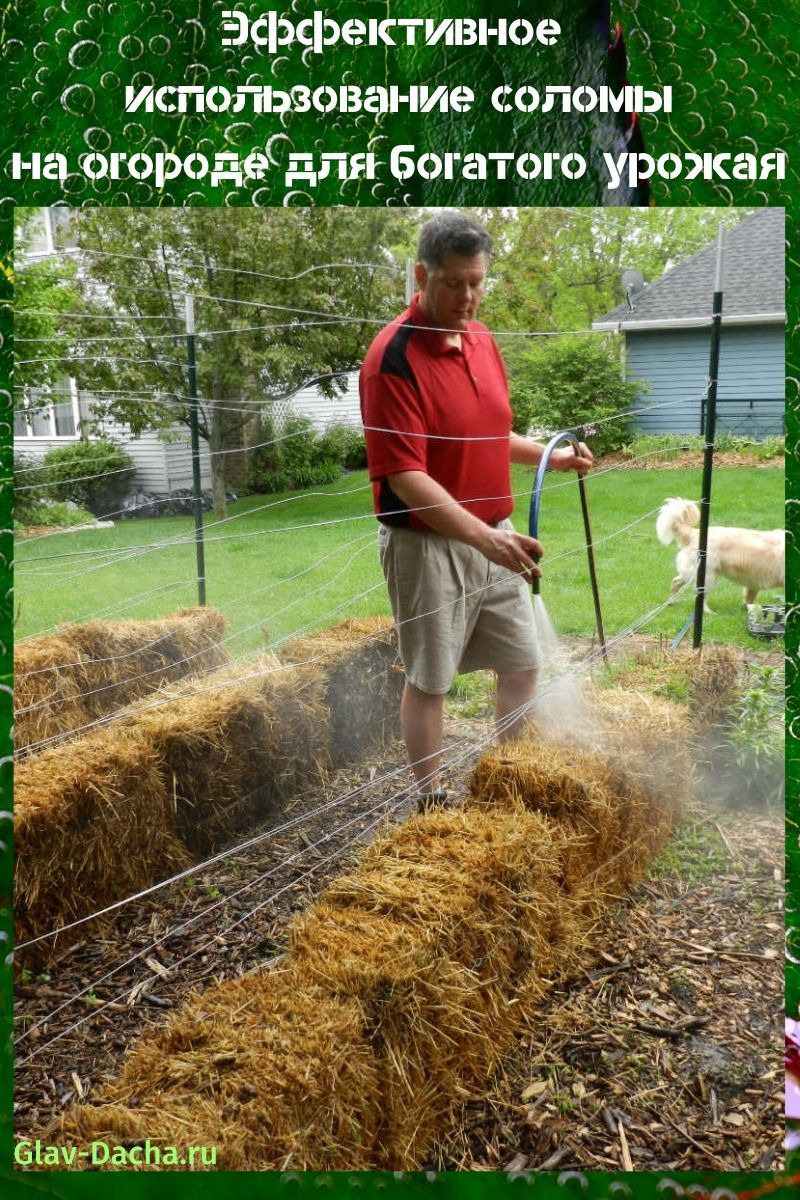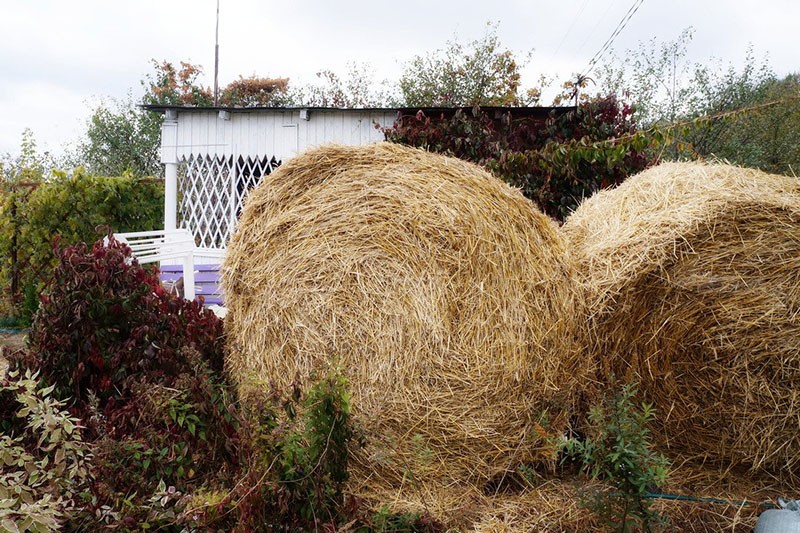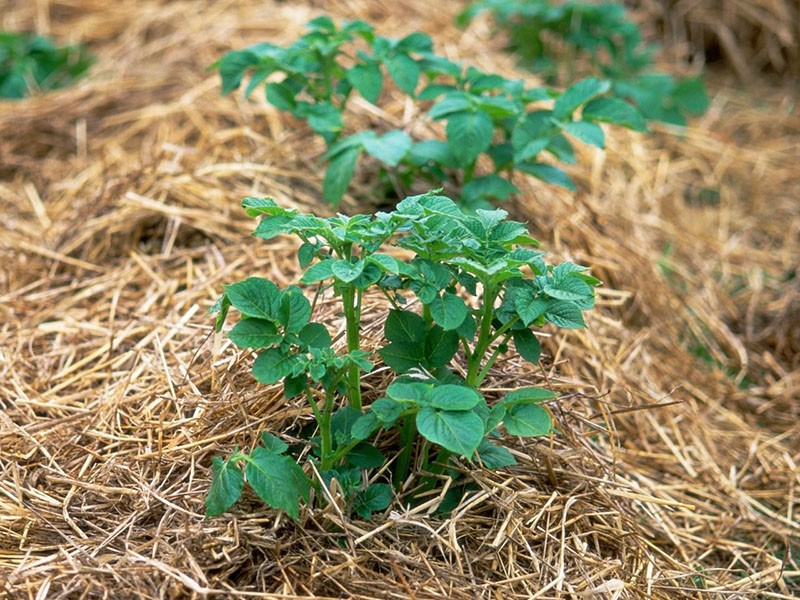Effective use of straw in the garden for a rich harvest
 Growing vegetables quickly depletes the soil, reducing its fertile qualities. Using straw in the garden helps to restore soil structure, saturate it with nutrients and improve quality. Also, straw is an excellent universal plant protector: in winter from hypothermia and freezing, and in summer from insect pests.
Growing vegetables quickly depletes the soil, reducing its fertile qualities. Using straw in the garden helps to restore soil structure, saturate it with nutrients and improve quality. Also, straw is an excellent universal plant protector: in winter from hypothermia and freezing, and in summer from insect pests.
Straw chemical composition

Straw chemical composition:
- organic fiber;
- vegetable proteins;
- extractive nitrogen-free substances - lignin, hemicellulose, starch, sucrose;
- fats;
- ash.
 The straw contains a large amount of micro- and macroelements - sodium, magnesium, phosphorus, sulfur, calcium, chlorine, manganese, zinc, cobalt. It also contains a complex of nonessential and essential amino acids, which include tryptophan, lysine, cystine.
The straw contains a large amount of micro- and macroelements - sodium, magnesium, phosphorus, sulfur, calcium, chlorine, manganese, zinc, cobalt. It also contains a complex of nonessential and essential amino acids, which include tryptophan, lysine, cystine.
In terms of the amount of active organic substances, straw raw materials are 2-3 times higher than cow dung, which ensured the popularity of using straw in the garden.
The benefits and harms of straw in the garden
 The use of straw in the garden is based on the principle of organic farming, which determines the main advantages and disadvantages of this plant matter.
The use of straw in the garden is based on the principle of organic farming, which determines the main advantages and disadvantages of this plant matter.
The main advantages of straw:
- Replenishment of humic substances in the soil, rapid formation of humus during decomposition.
- Saturation of soil with all necessary vitamins, minerals and amino acids.
- Minimum financial costs and unpretentious storage.
- Improving the structure of the soil, as well as its ability to absorb and transmit moisture to the root system of plants.
- Increase in soil looseness, which has a positive effect on the growth of vegetable crops.
- Saturates the soil with carbon, stimulating plant photosynthesis.
- As a mulch, it protects cultivated crops from frost, insects and weeds.
 The benefits or harms of straw in your garden depends on how you use it. This organic substance also has several disadvantages. In some cases, the straw may contain larvae or eggs of pests that impair plant growth.
The benefits or harms of straw in your garden depends on how you use it. This organic substance also has several disadvantages. In some cases, the straw may contain larvae or eggs of pests that impair plant growth.
In addition, the maturation of the straw is quite long. Useful substances will get into the soil no earlier than 2-3 years after its introduction. In the process of decomposition, raw materials release harmful acids that can harm the root system of vegetables.
Using straw in the garden
 Straw has found wide application in horticulture. It is used as organic fertilizer, mulch, is added to the composition for composting.
Straw has found wide application in horticulture. It is used as organic fertilizer, mulch, is added to the composition for composting.
What is straw used for in the country:
- for feeding garden and vegetable crops;
- as a mulching material;
- for pre-winter shelter of plants;
- as a substrate for growing vegetables;
- for composting.
 Straw perfectly restores the soil, saturating it with useful trace elements and other nutrients.
Straw perfectly restores the soil, saturating it with useful trace elements and other nutrients.
Organic fertilizer
Straw as an organic fertilizer is introduced into the soil during the autumn digging of the soil. It can be laid both whole and after preliminary grinding.Before laying, it is imperative to consider how to chop the straw for the substrate - its size should be at least 10 cm and not more than 16 cm.The height of the slices should not exceed 22 cm.
In order for the rotting of straw to proceed as actively as possible, it must be laid in the soil to a depth of 13-16 cm and provide abundant moisture in the soil. Plant dressing is applied at the rate of about 100 kg per 1 ha.
Straw works best in combination with nitrogen, therefore it is recommended to combine plant fertilization with this mineral element. The optimal proportion is 1.5 kg of nitrogenous substance per 100 kg of straw.
This method of using straw also has a significant drawback. A large amount of organic feeding can cause the development of molds. In this case, the soil must be loosened again and complex mineral fertilizers with an increased concentration of nitrogen must be applied.
If carried out correctly, autumn burial improves air exchange in the soil, as well as its absorption properties.
Straw ash feeding
 Many gardeners use top dressing from straw ash, as it contains up to 25-35% potassium and other equally valuable trace elements. To prepare the fertilizer, straw must be burned and sprinkled with it on all garden plants at the rate of 60-70 g per 1 sq. m.
Many gardeners use top dressing from straw ash, as it contains up to 25-35% potassium and other equally valuable trace elements. To prepare the fertilizer, straw must be burned and sprinkled with it on all garden plants at the rate of 60-70 g per 1 sq. m.
Composting
 One of the popular ways to use straw in the country is to make compost.
One of the popular ways to use straw in the country is to make compost.
A compost heap usually consists of several layers, for which various organic substances are used:
- chopped straw - 300 kg;
- chopped grass - 40 kg;
- mineral solution - pure water (80 l), saltpeter (8 kg), superphosphate (12 kg) and potassium chloride (12 kg).
Straw as a fertilizer for the garden, prepared in this way, can be applied to the soil after 1 year. But many gardeners recommend doing this only after 2 years.
Mulching
 Seedling straw is most often used as a mulching material. Thanks to a layer of straw mulch, the need for irrigation of plants is noticeably reduced, since it retains moisture well in the soil.
Seedling straw is most often used as a mulching material. Thanks to a layer of straw mulch, the need for irrigation of plants is noticeably reduced, since it retains moisture well in the soil.
Weeds do not grow through the layer of straw, so there is no need for regular loosening of the area. Straw mulch reliably protects the root system of plants from freezing and overheating.

Features of the use of straw as mulch:
- plants take shelter in spring;
- scatter straw in a layer of 13-15 cm around plants, fruit bushes and trees;
- the layer of mulching material should not be too thin, as over time the straw cakes and becomes thinner.
The use of straw for mulching also has a significant disadvantage - it reduces the amount of nitrogen in the soil.
 As a result, plants may feel a deficiency of this element, their growth and development are suspended. To solve this problem, you need to feed the plants with nitrogen-containing fertilizers.
As a result, plants may feel a deficiency of this element, their growth and development are suspended. To solve this problem, you need to feed the plants with nitrogen-containing fertilizers.
Growing vegetables
 Straw is often used in home gardens as a substrate for growing vegetables, most often potatoes. To do this, a layer of peat must be poured onto a previously prepared bed - its thickness should be at least 18-20 cm.
Straw is often used in home gardens as a substrate for growing vegetables, most often potatoes. To do this, a layer of peat must be poured onto a previously prepared bed - its thickness should be at least 18-20 cm.
On top of the peat, you need to lay out seed potatoes (this can be done both diagonally and in even rows) and cover it with straw. Level the straw well and add another layer, tamp. As a result, the height of the common layer should be 28-30 cm.
After that, seedlings can be expected to appear. If the weather is dry, the garden will need to be watered, but no more than 2 times during the summer season. At the end of August, remove the mulch layer of straw and harvest.
The main mistakes when using straw in the garden
 Straw has a complex effect on the soil, increasing its fertile qualities and improving the structure. But in some cases, this organic feeding may not bring any results.
Straw has a complex effect on the soil, increasing its fertile qualities and improving the structure. But in some cases, this organic feeding may not bring any results.
Errors when using straw on the site:
- Embedding whole straw into the soil without prior chopping. The decomposition of large plant particles will take at least 2 years. During this time, the fertile qualities of the garden plot will not change for the better.
- Excessive dryness of the soil. The active vital activity of soil microorganisms is possible only at high humidity. When embedding straw in the soil, it must be watered abundantly, otherwise the decomposition of the fertilizing will be long and ineffective.
- Lack of nitrogen - the decomposition of straw is accompanied by a decrease in the concentration of nitrogen in the soil. To prevent nitrogen starvation of plants, after using top dressing, you need to add saltpeter or other nitrogen-containing fertilizers.
Straw is a versatile and natural material that is irreplaceable in the garden. It is used as an effective organic fertilizing and mulching material, preparing high-quality compost and a nutritious substrate for growing vegetables. When used correctly, straw will improve the structure and fertility of the soil, ensuring an excellent harvest of vegetables and fruits.